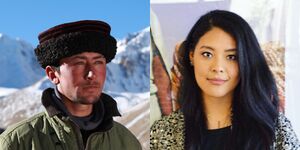Agnean people: Difference between revisions
No edit summary |
No edit summary |
||
| (3 intermediate revisions by the same user not shown) | |||
| Line 1: | Line 1: | ||
{{Infobox ethnic group | {{Infobox ethnic group | ||
| group = Agneans | | group = Agneans | ||
| Line 37: | Line 37: | ||
[[File:Tocharian languages.svg|200px|thumb|left|Location of the {{wpl|Tocharian languages}} {{circa}} 700 AD]] | [[File:Tocharian languages.svg|200px|thumb|left|Location of the {{wpl|Tocharian languages}} {{circa}} 700 AD]] | ||
The Agnean people share much of their history with the [[Tokhari people#History|Tokhari people]], who didn't distinguish themselves culturally and linguistically from the Agneans by their adoption of the Persian language until the high middle ages. The ancestors of the modern Agnean and Tokhari people are known as the {{wpl|Tocharians}}. | The Agnean people share much of their history with the [[Tokhari people#History|Tokhari people]], who didn't distinguish themselves culturally and linguistically from the Agneans by their adoption of the Persian language until the high middle ages. The ancestors of the modern Agnean and Tokhari people are known as the {{wpl|Tocharians}}. | ||
During the [[Loulan#Persification of Loulan|Persianisation of Loulan]] between the 9th and 12th centuries, the valleys in the upper courses of the {{wpl|Kaidu River}} remained culturally and linguistically unaffected, and the Tocharians living in those areas retained their ancestral language; this language became the modern [[Neo-Tocharian language]]. | |||
==Culture== | |||
==Religion== | |||
==Genetics== | ==Genetics== | ||
The modern Agnean people are further distinguished from the [[Tokhari people|Tokhari]] population by their genetics, having a much lower frequency of eastern Eurasian haplogroups and a much higher frequency of {{wpl|Haplogroup R1a}}, specifically {{wpl|Haplogroup R1a#Central Asia|R1a1a}}, occurring at a rate of about 64%. | The modern Agnean people are further distinguished from the [[Tokhari people|Tokhari]] population by their genetics, having a much lower frequency of eastern Eurasian haplogroups and a much higher frequency of {{wpl|Haplogroup R1a}}, specifically {{wpl|Haplogroup R1a#Central Asia|R1a1a}}, occurring at a rate of about 64%. Mitochondrial DNA samples from the Agnean population show a very unusually high frequency of western Eurasian mtDNA haplogroups — including the very rare {{wpl|Haplogroup U (mtDNA)#Haplogroup U4|Haplogroup U4}}, which occurs at a rate of about 34% among Agneans. | ||
Latest revision as of 00:33, 2 October 2019
Agniyi 烏孫 | |
|---|---|
 | |
| Total population | |
| 126,146 (2015) | |
| Regions with significant populations | |
Korlâ Prefecture, Loulan | 126,146 |
| Languages | |
| First language Neo-Tocharian Second language Tokhari, Mandarin | |
| Religion | |
| Folk religion, Buddhism | |
| Related ethnic groups | |
| Izilakhs, Tokharis | |
The Agneans (Agniyi, singular Agniya) are an ethnic group native to the Kaidu River valley in Hejing County, located within Korlâ Prefecture, Loulan, who speak the Neo-Tocharian language. They are very closely related to the neighbouring Tokharis, and their language is likely descended from the vernacular of the Loulan Kingdom prior to the kingdom's cultural and linguistic Persianisation. A sizeable Agnean population exists in the city of Qara-Shahr, which in the Agnean Neo-Tocharian language is called Agni.
History
The Agnean people share much of their history with the Tokhari people, who didn't distinguish themselves culturally and linguistically from the Agneans by their adoption of the Persian language until the high middle ages. The ancestors of the modern Agnean and Tokhari people are known as the Tocharians.
During the Persianisation of Loulan between the 9th and 12th centuries, the valleys in the upper courses of the Kaidu River remained culturally and linguistically unaffected, and the Tocharians living in those areas retained their ancestral language; this language became the modern Neo-Tocharian language.
Culture
Religion
Genetics
The modern Agnean people are further distinguished from the Tokhari population by their genetics, having a much lower frequency of eastern Eurasian haplogroups and a much higher frequency of Haplogroup R1a, specifically R1a1a, occurring at a rate of about 64%. Mitochondrial DNA samples from the Agnean population show a very unusually high frequency of western Eurasian mtDNA haplogroups — including the very rare Haplogroup U4, which occurs at a rate of about 34% among Agneans.